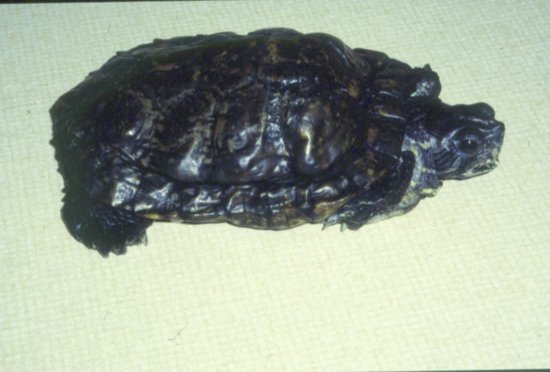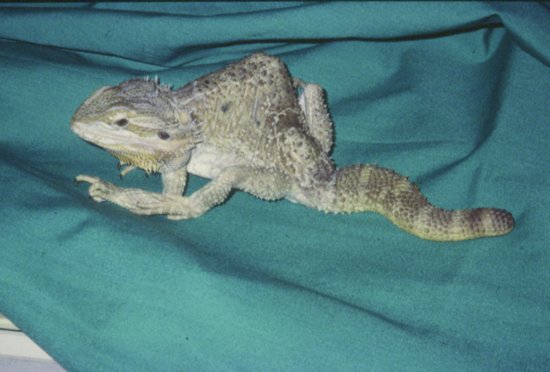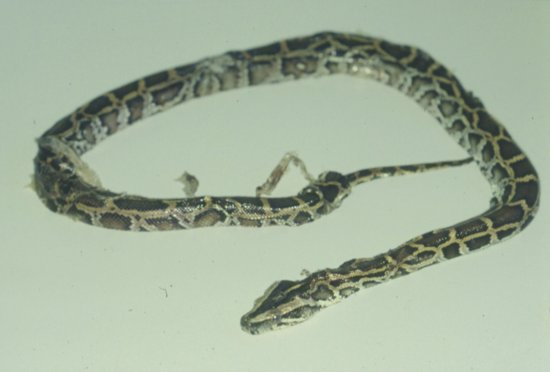For example, vegetables such as lettuce and celery have an energy content of 12.6 kJ/g dry matter (or in real terms 0.75 kJ/g wet food), whereas meat-based foods such as rodent prey have a much higher energy density of 19–21 kJ/g dry matter (or in real terms 6–7.5 kJ/g wet food) (Donoghue, 1998). From this we can see that in ‘as fed’ terms, i.e. wet food, one would need to feed eight times as much weight of vegetable matter to give the same energy dose in animal prey. This volume may well exceed the gut capacity of the reptile or amphibian.
Conversely many pet reptiles and amphibians will continue eating until their digestive tracts are full, and if all they are offered is high energy density food then they will rapidly achieve their MER, exceed it and become obese.
Protein and amino acid requirements
Proteins are assembled from groups of amino acids – indeed a protein can contain up to 22 amino acids. In general terms, for humans, and it seems for reptiles and amphibians, 10 amino acids are essential and need to be provided in the diet. The others may be manufactured from these 10. The essential amino acids are:
|
|
In addition, it is known that for diets low in the amino acids methionine or arginine, an extra supplement of the amino acid glycine is required.
Proteins are therefore assessed on their ability to provide these essential amino acids, with poor proteins supplying only non-essential ones. This is quantified by the term biological value, a high-biological-value foodstuff containing more of the essential amino acids.
For herbivorous reptiles, levels of 25% protein content as metabolisable energy in the diet have been shown to be adequate (Donoghue, 1998). Most of this protein source in herbivores seems to come from leafy greens, but deficiencies are seen in herbivorous reptiles fed high cellulose, low-protein foods such as the ubiquitous lettuce, and fruits. Chronic protein deficiencies are often presented as gradual wasting conditions, with increased susceptibility to infections.
Deficiencies in amino acids in carnivorous reptiles and amphibians are extremely rare because they eat the whole prey. This gives them 30–60% protein content as metabolisable energy. Herbivorous deficiencies specific amino acids are possible, although not well documented.
In general, waste products of protein metabolism in land-based reptiles are converted into the relatively insoluble uric acid. Alligators may produce ammonia as the waste product, as may many amphibians, depending on their state of hydration, but adult frogs may excrete urea. Protein excesses, such as those produced by feeding cat- or dog foods to predominantly herbivorous species, can lead to an excess production of uric acid; visceral gout, renal failure and death may result.
Fats and essential fatty acids
Fats provide high concentrations of energy. They also supply the reptile or amphibian with essential fatty acids (EFAs), which are required for cellular integrity and as the building blocks for internal chemicals such as prostaglandins (which play a part in reproduction and inflammation). Fats also provide a carrier mechanism for the absorption of fat-soluble vitamins such as vitamins A, D, E and K.
The primary EFA for reptiles is linoleic acid, as it is for mammals, with the absolute dietary requirement of this fatty acid being 1% of the diet. If the diet becomes deficient in this EFA, a rapid decline in cellular integrity occurs. This is manifested clinically by the skin becoming flaky, inelastic, and prone to recurrent infections and also to fluid loss through the skin, which in turn leads to polydipsia (Wallach & Hoff, 1982).
In herbivores, less than 10% of the diet on a dry matter basis is composed of fats, the chief energy sources being carbohydrates and proteins. However, fermentation of fibre in the lower bowel produces short-chain fatty acids which can be used for energy. For carnivores, fat forms a major part of the energy source in the diet, as much as 40–70% of the calories, with protein chiefly making up the rest.
The problem of overconsumption of fats in pet reptiles which are not exercising regularly is well known, and high fat foods such as dog- and cat food fed to herbivores, or extremely fat rodent prey fed to snakes, are prime culprits for this. Obesity can lead to a number of problems, high amongst which is fatty degenerative change in the liver (hepatic lipidosis), which can lead to liver failure. This is particularly common in tortoises.
Carbohydrates
Carbohydrates are primarily used for rapid energy production. This is particularly important in herbivores which consume plant matter only, and so gain the majority of their energy source from carbohydrates and proteins. Carnivorous reptiles do not utilise carbohydrates much at all.
Fibre
Dietary fibre is extremely important for herbivorous reptiles. Indeed, the presence of fibre acts both as a bulking agent, encouraging gut motility, and as a source for fermentation by the intestinal microflora, essential for fatty acid and B vitamin production. Snakes and other carnivores do not have a dietary fibre requirement, and indeed if provided fibre will not be utilised. Ultimately it will dilute the energy concentration of the diet, necessitating feeding more frequent and larger meals.
Vitamins
These compounds are grouped together although they are widely differing in nature, but all animals have a requirement for various numbers of these. They are categorised into fat-soluble (vitamin A, D, E and K) and water-soluble (the B vitamin complex and vitamin C).
Fat-soluble vitamins
Vitamin A
In herbivore reptiles, beta-carotene is the most important plant precursor in terms of how much vitamin A can be produced from it. Carnivorous reptiles and amphibians will gain the preformed vitamin A in their prey food.
Hypovitaminosis A is a frequently seen problem in chelonians, particularly in tortoises and young red-eared terrapins. If a deficiency in vitamin A occurs, then mucous membranes become thickened and oral and respiratory secretions dry up. This is due to blockage of salivary and mucous glands with cellular debris – a condition known as squamous metaplasia. This leads to poor functioning of the ciliary mechanisms which have a role in removing foreign particles from the airways. Swelling of the periorbital membranes – a condition known as xerophthalmia – is also seen.
Vitamin A’s role in immune system function means that a deficiency makes respiratory and digestive tract infections more common. The most frequently seen example of this is the increased susceptibility to pneumonias seen in red-eared terrapins and manifested in the lopsided position they adopt when swimming. This is because of lung collapse or congestion which reduces buoyancy on the affected side.
Tortoises may suffer more frequently from upper respiratory tract infections when a deficiency is present. Evidence of sterile pustules and cornified plaques inside the mouth are commonly seen, with overgrowth of the beak due to hyperkeratosis.
Vitamin A also has a role in bone growth and structure, the normal function of secretory glands such as the adrenals and also in reproductive function. Finally renal damage may occur in hypovitaminosis A, with evidence of oedema in the inguinal and axillary regions secondary to failure of the renal tubular filtration system.
Because it is fat soluble, vitamin A can be stored in the body, primarily in the liver. Recommended minimum dietary levels are 200–300 IU/kg for reptiles (Wallach & Hoff, 1982).
Hypervitaminosis A rarely occurs naturally but may be induced by overdosing with vitamin A injections at 1000 times or more the daily recommended doses. If this occurs, acute toxicity develops with mucous membrane and skin sloughing and frequently death within 24–48 hours. Vitamin A supplements are therefore often given orally as, due to slower absorption, this reduces the risk of this condition developing.
Vitamin D: Vitamin D3 is the most active form for calcium homeostasis, and plants are not effective as suppliers of this compound.
Cholecalciferol, the precursor of vitamin D3, is manufactured in the reptile or amphibian’s skin in a process enhanced by ultraviolet light. For this reason, indoor animals produce much less of this compound unless supplied with an effective artificial ultraviolet light source.
Hypovitaminosis D3 causes problems with calcium metabolism, and leads to rickets. This is exacerbated by low calcium, high phosphorus-containing diets. A typical sufferer would be a young growing reptile, kept indoors with no ultraviolet light supplementation and fed on a low-calcium diet – e.g. lettuce/celery/cucumber for herbivores, or meat only a day old mice/chicks for carnivorous species. The condition so produced is referred to as ‘metabolic bone disease’.
An animal so affected is frequently apparently ‘well-muscled’, due to poorly mineralised bones which increase their thickness to maintain their strength. There is often flaring of the epiphyseal plates at the ends of the long bones, with concomitant bowing of the limbs. Green iguanas and other herbivorous species such as terrestrial chelonians are particularly susceptible, with the lizards showing rachitic rosettes (Frye, 1991) due to flaring of the epiphysis in the ribs at the costochondral junction.
Chelonia develop ‘lumpy shell’, a deformity of the carapace in particular, where the edges roll upwards creating a ‘Cornish pasty’ effect, and the muscles which attach the limbs to the inside of the shell, pull the carapace downwards creating pits either side cranially and caudally (Figure 20.3). Recommended maximum levels are 50–100 IU/kg every other day.
Figure 20.3 Red-eared terrapin, Trachemys scripta elegans, with hypovitaminosis D3. (Reproduced with permission from Girling & Raiti, 2004, © BSAVA)

Hypervitaminosis D3 occurs due to over supplementation with D3 and calcium and leads to calcification of soft tissues, such as the medial wall of the arteries, and the kidneys, creating hypertension and organ failure. This often occurs in herbivores such as tortoises fed on tinned cat and dog food.
Vitamin E
Hypovitaminosis E may occur due to a reduction in fat metabolism or absorption, such as can occur in small intestinal, pancreatic or biliary diseases, or due to a lack of dietary green plant material for herbivores. A relative deficiency will occur in species eating large amounts of polyunsaturated fats, e.g. marine fish such as tuna and mackerel. These use up the body’s vitamin E reserves. A condition called steatitis, wherein body fat starts to necrose, has been seen in gharials (a fish-eating crocodilian) (Frye, 1991) and terrapins.
Hypervitaminosis E is extremely rare.
Vitamin K
Because of its production by gut bacteria, it is very difficult to get a true deficiency, although absorption will be reduced when fat digestion or absorption is reduced, as in biliary or pancreatic disease. The consumption of warfarin- and coumarin-derived compounds (as found in sweet clovers) can increase the demand for clotting factors, and this may also be seen in snakes consuming prey which has been killed by these rodenticides. Disease so caused is characterised by increased internal and external haemorrhage, but vitamin K also has some function in calcium/phosphorous metabolism in bone so this may also be affected. Frye (1991) has recorded disease in crocodiles exhibiting gingival bleeding without petechiation. Recommended minimum levels for reptiles are 1 ppm (Wallach & Hoff, 1982).
Water-soluble vitamins
Vitamin B1 (thiamine)
A source of thiaminases, enzymes which destroy thiamine, is raw saltwater fish which may be fed to some snakes, crocodilians and turtles, such as garter snakes, red-eared terrapins and gharials. There are thiamine antagonists as well in blackberries, beetroot, coffee, chocolate and tea when considering herbivores. When a relative deficiency occurs, neurological signs such as opisthotonus, weakness and head tremors may be seen. In garter and water snakes, a classical inability to right itself occurs, with the snake continually flipping onto its back. In addition, fungal infections are reported as more likely after a B1 deficiency. The recommended minimum level for reptiles is 20–35 mg/kg food offered. In addition, if sea-fish such as smelt, which are high in thiaminases, are to be fed, cooking the fish for 5 minutes at 80°C deactivates the thiaminase. In a reptile with thiamine deficiency, doses of 50–100 mg/kg body weight should be given. Because of this problem it is often advised that garter and water snakes be fed on rodent prey rather than sea-fish. They may be encouraged to eat this by wiping the rodent prey with the fish to which it is accustomed to cover the scent.
Biotin
Deficiencies do occur commonly in Gila monsters, beaded lizards and monitor lizards, all of which enjoy raw eggs in the wild. In this state the majority of eggs are fertile, and contain little avidin (an antibiotin vitamin). However, unfertilised hen’s eggs are high in avidin so a relative biotin deficiency may occur. Deficiencies produce muscular weakness, occasionally with skin lesions. It is therefore recommended that minimal levels of raw eggs are fed to such reptiles.
Folic acid
A deficiency of folic acid is rare but can lead to severely impaired cellular division. This can lead to a number of obvious problems, such as females’ reproductive tracts not maturing, macrocytic anaemia due to failure of red blood cell maturation and immune system cellular dysfunction. A relative deficiency of folic acid may occur in some individuals fed a very high protein diet, as folic acid is needed to produce the waste products of protein metabolism in reptiles, uric acid. In addition, there are inhibitors of folic acid in some foods such as cabbage and other brassicas, oranges, beans and peas. The use of trimethoprim sulphonamide drugs also reduces gut bacterial folic acid production.
Vitamin B12
Vitamin B12 is produced generally by intestinal bacteria and so deficiencies are uncommon but may occur after prolonged antibiotic medication. Deficiency produces slow growth, muscular dystrophy in the legs, poor hatching rates, high mortality rates and hatching deformities in young reptiles and amphibians.
Choline
Choline may be synthesised in the body, but not in enough quantities for the growing reptile. Because of interactions, the need for choline is dependent on levels of folic acid and vitamin B12. Excess protein, therefore, as with folic acid, increases choline requirements, as does a diet high in fats. Deficiency causes retarded growth, disrupted fat metabolism and fatty liver damage.
Vitamin C
There is no direct need for this vitamin in reptiles and amphibians as vitamin C may be produced from glucose in the outermost portions of the kidneys. However, during disease processes, particularly those which affect liver function, it may be beneficial to the recovery process to provide a dietary source of vitamin C. It is required for the formation of elastic fibres and connective tissues and is an excellent anti-oxidant similar to vitamin E. Deficiency leads to ‘scurvy’ where there is poor wound healing, increased bleeding due to capillary wall fragility and bone alterations. Deficiency has been postulated as the cause of skin splitting in snakes fed rodent prey that had been starved for 24–48 hours before being fed (Frye, 1991). This allowed the emptying of their gastrointestinal tract, and hence reduced levels of vitamin C from the plant material therein. It has also been suggested that increasing vitamin C levels by supplementation at levels of 10–20 mg/kg intramuscularly or orally (Frye, 1991) may be useful in the treatment of chronic infections, such as ‘mouth rot’ in snakes.
Minerals
As with mammals there are two main groups of minerals, those classified as macro-minerals, i.e. those present in large amounts in the body, such as calcium and phosphorus, and micro-minerals, or trace elements, such as manganese, iron and cobalt, which are all necessary for normal bodily function.
Macro-minerals
Calcium
Calcium has a wide range of bodily functions, the two most obvious being its role in the formation of the skeleton and mineralisation of bone matrix, and its requirement for muscular contractions. The active form of calcium in the body is the ionic double charged molecule Ca2+. Low levels of this form, even though the overall body reserves of calcium are normal, leads to hyperexcitability, fitting and death, conditions seen in gravid female egg-bound green iguanas.
The ratio of calcium to phosphorus is important – as one increases, the other decreases and vice versa. This is controlled by the hormones calcitonin, parathyroid hormone and the accessory hormone vitamin D3. A ratio of 2:1 calcium to phosphorus is desirable in growing reptiles and 1.5:1 for adults. In high egg laying periods though, to keep pace with the output of calcium into the shells, a ratio of 10:1 may be needed.
Calcium deficiency causes nutritional osteodystrophy, or metabolic bone disease, and is often accompanied by deficiency in vitamin D3. Normal levels of vitamin D3, however, may exacerbate this disease as they encourage further calcium resorption. Deficiency may be seen in lizards such as green iguanas and water dragons, and chelonians fed on diets high in fruit, lettuce, celery, etc.. Diets with excessive levels of oxalates, compounds which bind up calcium and prevent it being absorbed, such as spinach and beetroot or rhubarb leaves, can also lead to a deficiency.
Calcium deficiency may also be seen in insectivorous species, such as geckos, and bearded dragons, fed on insects without supplementation (Figure 20.4). Insects have little or no calcium, their tough outer coat is made of a protein known as chitin. To provide adequate calcium therefore, the insect must be dusted with a calcium powder immediately before being fed (if not, by the time the reptile has caught the insect most of the powder has fallen off!). Alternatively, the insect is pre-fed on a calcium supplement. This is mixed in with the insect’s food and fed for the 24–48 hours before feeding the reptile, so that the insect’s gut is pre-loaded with calcium.
Figure 20.4 Bearded dragon, Pogona vitticeps, with metabolic bone disease and resultant spinal and limb deformity.

Stay updated, free articles. Join our Telegram channel

Full access? Get Clinical Tree



